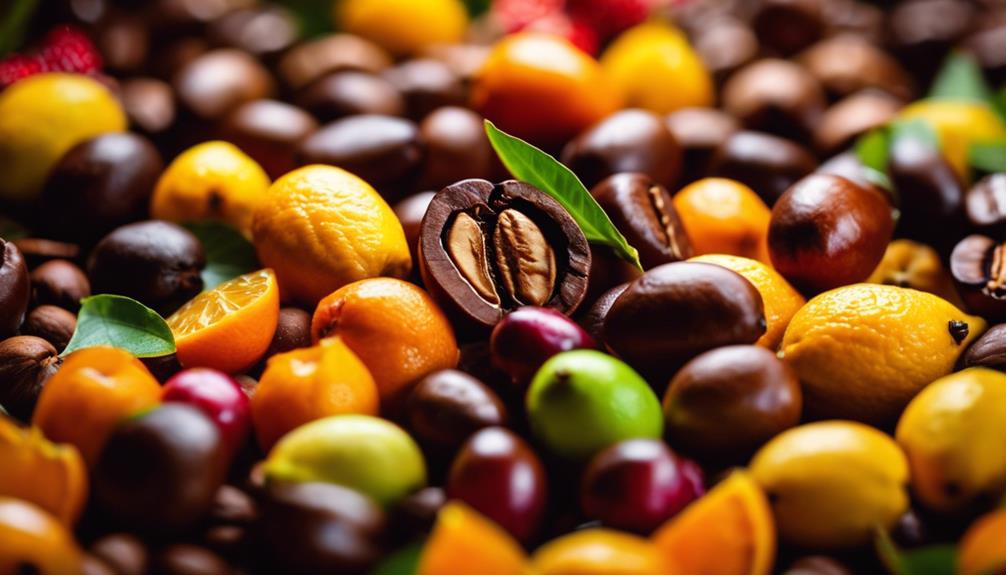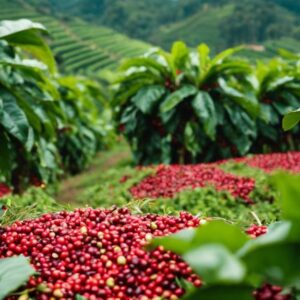If you’ve ever savored a cup of specialty Arabica coffee and noticed its bright, tangy notes, you might have wondered about its acidity levels.
Understanding the acidity of Arabica coffee involves unraveling a complex interplay of factors that go beyond just taste.
Dive into the world of Arabica coffee’s acidity to uncover not only its impact on flavor but also its potential health implications.
Stay tuned to explore the delicate balance between acidity, taste, and your well-being.
Is Arabica Coffee Acidic?

Do you wonder about the acidity of Arabica coffee beans?
Let’s explore the different acids found in Arabica coffee and compare its acidity levels to Robusta coffee.
Understanding the acidity of Arabica coffee can help you appreciate its flavor profile better.
The Acids of Arabica Coffee
When it comes to Arabica coffee, understanding its acidity is key to appreciating its aromatic and flavor profiles. The acids found in Arabica coffee contribute to its bright, tangy, and sometimes fruity notes that coffee lovers enjoy.
Below is a table highlighting some of the main acids present in Arabica coffee and their flavors.
| Acid | Flavor Profile |
|---|---|
| Citric | Citrusy, Fresh |
| Malic | Apple-like, Tart |
| Acetic | Vinegary, Sharp |
| Quinic | Bitter, Astringent |
| Phosphoric | Mineral, Tangy |
The Influence of Acidity on Coffee’s Aromatic and Flavor Qualities
Acidity in Arabica coffee plays a crucial role in enhancing its aromatic profile and flavor characteristics.
- Dynamic Aromas: Acidity contributes to the complex and vibrant aromas that captivate your senses.
- Enhanced Flavor Notes: It elevates the taste experience by adding brightness and depth to the coffee’s flavor profile.
- Balanced Complexity: The right level of acidity creates a harmonious balance of flavors for a truly enjoyable cup.
- Memorable Taste: Acidity is the secret ingredient that makes each sip a memorable and unique experience.
A Detailed Look at Arabica vs. Robusta: Acidity Levels Unveiled
Get ready to compare the acidity levels of Arabica and Robusta coffee. Discover the distinct taste profiles of Arabica’s acidity and gain insight into how Robusta’s acidity stacks up in comparison.
Unveil the secrets behind the acidity of these two popular coffee varieties.
Exploring Arabica’s Distinct Acidity: A Taste Profile Analysis
Exploring Arabica’s distinct acidity reveals a nuanced taste profile that sets it apart from Robusta coffee varieties. Arabica’s acidity is often described as bright and complex, adding vibrancy to its flavor.
This acidity can exhibit fruity, floral, or wine-like notes. The balanced acidity of Arabica beans contributes to a smooth and pleasant drinking experience, making it a popular choice among coffee enthusiasts seeking a sophisticated palate.
Robusta’s Acidity Uncovered: A Comparative Perspective
As you shift your focus to Robusta coffee, you’ll uncover a contrasting acidity profile that distinguishes it from its Arabica counterpart. Robusta beans typically exhibit a higher acidity level compared to Arabica, providing a bolder and more robust flavor profile. This difference in acidity can be a crucial factor for those seeking a low-acid coffee option.
Explore the table below for a quick comparison:
| Aspect | Arabica Coffee | Robusta Coffee |
|---|---|---|
| Acidity | Higher | Lower |
| Flavor | Bright, Fruity | Bold, Earthy |
| Caffeine | Lower | Higher |
| Price | Higher | Lower |
| Growing | High altitude | Low altitude |
Factors Influencing Arabica Coffee’s Acidity

When it comes to Arabica coffee acidity, you’ll find that the type of coffee beans used and the roast levels play a significant role.
The brewing method also has a notable impact on how acidic your cup of Arabica coffee will taste.
Understanding these factors can help you tailor your coffee experience to suit your preferences.
Diving into the Role of Coffee Bean Varieties on Acidity
Arabica coffee’s acidity profile is significantly influenced by the specific varieties of coffee beans used in its production. When exploring the impact of bean varieties on acidity, consider the following:
- Origin Diversity: The region where Arabica beans are grown plays a crucial role in determining the acidity levels. Beans from different regions can offer unique acidity profiles.
- Genetic Variability: Various Arabica coffee varieties have distinct genetic compositions, influencing the acidity in the cup. Genetic diversity can lead to a wide range of acidity levels.
- Growing Conditions: Factors like altitude, soil composition, and climate affect how acidic the coffee beans become. Ideal conditions can enhance the acidity.
- Processing Methods: Different processing techniques post-harvest can either enhance or diminish the natural acidity of Arabica beans. Processing plays a vital role in preserving acidity.
Roast Levels and Their Pronounced Impact on Acidity
When it comes to Arabica coffee’s acidity, roast levels play a crucial role in shaping the flavor profile.
Light roasts tend to preserve more of the bean’s natural acidity, resulting in a brighter and more pronounced tang on your palate.
Conversely, dark roasts often mellow out the acidity, offering a smoother and richer taste experience.
Navigating the Acidity Spectrum: From Light to Dark Roasts
Navigating the acidity spectrum in Arabica coffee involves understanding how roast levels significantly influence the coffee’s overall acidity profile. Roasting transforms the beans, impacting their acidity levels.
Light roasts tend to be more acidic, with bright and tangy notes, while dark roasts are often less acidic, showcasing deeper, richer flavors. Experimenting with different roast levels allows you to discover the perfect balance of acidity in your cup.
| Light Roast | Dark Roast |
|---|---|
| Bright and Tangy | Deep and Rich |
| High Acidity | Low Acidity |
The Effect of Brewing Methods on Arabica’s Acidity
When brewing Arabica coffee, the method you choose can significantly impact its acidity. Espresso tends to have a more concentrated and intense flavor profile, which can sometimes mask acidity.
Pour-over methods often highlight the bright and vibrant acidity of Arabica beans.
Cold brew, on the other hand, tends to produce a smoother and less acidic cup of coffee.
A Comparative Analysis: Espresso, Pour-Over, and Cold Brew
Exploring how brewing methods influence the acidity of Arabica coffee reveals distinct flavor profiles in espresso, pour-over, and cold brew preparations.
Each method offers a unique taste experience due to varying extraction times and temperatures. Espresso provides a concentrated, bold flavor, while pour-over brings out a nuanced acidity. Cold brew, on the other hand, offers a smoother, less acidic profile perfect for those who prefer a milder taste.
| Espresso | Pour-Over | Cold Brew |
|---|---|---|
| Bold flavor | Nuanced acidity | Smooth, less acidic |
Arabica Coffee’s Acidity: Characteristics and Benefits

When exploring Arabica coffee’s acidity, you’ll uncover a unique flavor profile that sets it apart.
The sensory journey of Arabica’s acidity plays a crucial role in shaping its overall taste experience.
Understanding these characteristics can enhance your appreciation of this beloved coffee variety.
Unraveling the Unique Flavor Profile of Arabica’s Acidity
Unveiling the distinct acidity of Arabica coffee can enhance your understanding of its complex flavor profile and potential health benefits. Arabica’s acidity is a key component that contributes to its unique taste experience. Here’s a deeper look at what makes Arabica’s acidity stand out:
- Brightness: Arabica’s acidity often presents as a bright, lively sensation on your palate, adding a refreshing quality to each sip.
- Fruitiness: The acidity in Arabica can manifest as fruity notes, providing a delicate sweetness that complements its overall flavor profile.
- Balance: Arabica’s acidity is well-balanced, harmonizing with other flavor elements to create a multidimensional taste.
- Health Benefits: The acidity in Arabica coffee has been linked to potential health benefits, such as aiding digestion and boosting metabolism.
The Sensory Journey: Arabica’s Acidity and Its Impact on Taste
When you sip on a cup of Arabica coffee, the acidity you taste isn’t a negative trait but a key player in creating a rich and vibrant flavor profile. Embrace the acidity in your coffee as a sign of its high quality and complexity, enhancing your overall sensory experience. Let’s explore the characteristics and benefits of Arabica coffee’s acidity further to appreciate its contribution to your daily brew.
CHARACTERISTICS AND BENEFITS OF ARABICA COFFEE’S ACIDITY:
- Complex Flavor Profile: Acidity adds layers of brightness and complexity to the taste of Arabica coffee.
- Quality Indicator: The presence of acidity often signifies a higher quality coffee bean.
- Enhanced Sensory Experience: Acidity can elevate the overall drinking experience by providing a lively and engaging sensation on your palate.
- Balanced Taste: When acidity is well-balanced, it can contribute to a harmonious flavor profile that delights the taste buds.
The Role of Acidity in Crafting a Complex Flavor Profile
Crafting a complex flavor profile in Arabica coffee involves understanding the essential role that acidity plays in enhancing the overall taste experience.
Acidity in coffee brings a vibrant brightness. It balances sweetness and bitterness. It contributes to a lively and dynamic tasting experience.
Acidity is crucial for creating a multidimensional and intriguing flavor profile that captivates the palate.
Acidity as a Hallmark of High-Quality Coffee
Acidity serves as a defining characteristic of high-quality Arabica coffee, contributing significantly to its flavor profile and overall sensory experience.
- Acidity in coffee indicates its vibrancy and liveliness.
- Quality Arabica beans often exhibit a balanced acidity.
- Acidity enhances the complexity of taste in specialty coffees.
- The acidity of Arabica coffee can range from bright and tangy to mild and soft, offering a wide spectrum of taste experiences.
Managing Acidity in Arabica Coffee

When it comes to managing acidity in Arabica coffee, mastering brewing techniques can help you modulate the level of acidity to suit your taste preferences.
Additionally, selecting Arabica beans based on their origin can also influence the acidity profile of your coffee.
Experimenting with different brewing methods and bean origins can lead to a personalized coffee experience tailored to your desired level of acidity.
Mastering Brewing Techniques to Modulate Acidity
When brewing Arabica coffee, consider using cold brew methods and coarse grinds to achieve a smoother taste profile. By adjusting your brewing techniques, you can effectively manage the acidity levels in your cup of Arabica coffee. Experiment with these methods to find the perfect balance that suits your taste preferences.
Tips for Mastering Brewing Techniques:
- Temperature Control: Experiment with different water temperatures to find the ideal balance between acidity and bitterness.
- Brewing Time: Adjust the brewing time to influence the extraction of flavors and acidity from the coffee grounds.
- Grind Size: Coarser grinds can lead to a less acidic brew, while finer grinds may intensify the acidity.
- Water Quality: Use high-quality water to brew your coffee, as water composition can significantly impact the final acidity of your cup.
Embracing Cold Brew and Coarse Grinds for a Smooth Experience
To achieve a smoother coffee experience while managing acidity in Arabica coffee, consider embracing cold brew and utilizing coarse grinds for optimal results.
- 1. Cold Brew Magic: Cold-brew extracts fewer acidic compounds, enhancing smoothness.
- 2. Coarse Grind Benefits: Coarse grinds reduce over-extraction, leading to a milder taste.
- 3. Extended Steeping Time: Longer steeping periods in cold brew can enhance flavor complexity.
- 4. Experiment with Ratios: Adjusting coffee-to-water ratios can fine-tune acidity levels for your preference.
The Art of Selecting Arabica Beans: Origin and Acidity
When selecting Arabica beans, you’ll want to consider the origin’s impact on the acidity and overall flavor profile of your coffee.
The region where the beans are grown can greatly influence the acidity levels and taste nuances in your cup.
Understanding these origins can help you manage and enhance the acidity in your Arabica coffee.
Decoding the Influence of Bean Origin on Acidity and Taste
Exploring the influence of bean origin on acidity and taste in Arabica coffee reveals the intricate relationship between where the beans are grown and the resulting flavors in your cup. When selecting Arabica beans, consider the origin’s impact on acidity and taste. Check out the table below for a quick reference on how different origins can affect your coffee experience.
| Origin | Acidity Level | Taste Profile |
|---|---|---|
| Ethiopia | High | Floral, Citrus |
| Colombia | Medium | Nutty, Chocolatey |
| Brazil | Low | Nutty, Caramel |
| Kenya | High | Berry, Wine-like |
| Guatemala | Medium | Fruity, Chocolatey |
The Health Implications of Arabica Coffee’s Acidity
When considering Arabica coffee’s acidity, it’s essential to understand its potential impact on your digestive system and dental health.
Navigating the acidity levels can contribute to maintaining digestive wellness, while also taking precautions to safeguard your teeth against the effects of acidity.
Being mindful of these health implications can help you enjoy your Arabica coffee without compromising your well-being.
Navigating Arabica Coffee’s Acidity for Digestive Wellness
If you often experience stomach sensitivity when drinking coffee, it’s essential to consider low acid coffee options to promote digestive wellness. Choosing coffee varieties with lower acidity levels can help reduce the risk of stomach discomfort and acid reflux.
By opting for low acid Arabica coffee, you can still enjoy your favorite brew without compromising your digestive health.
FOUR POINTS:
- Opt for Arabica coffee beans with a lower acidity level to support your digestive system.
- Low acid coffee varieties are gentler on the stomach, reducing the likelihood of gastrointestinal issues.
- Balancing coffee acidity can lead to a more comfortable drinking experience for individuals with sensitive stomachs.
- Prioritizing digestive wellness when selecting coffee can enhance your overall enjoyment of this beloved beverage.
Seeking Balance: Low Acid Coffee Varieties for Sensitive Stomachs
For those with sensitive stomachs, navigating the acidity of Arabica coffee can be crucial for maintaining digestive wellness. To cater to sensitive stomachs, consider trying these low acid coffee varieties:
| Low Acid Coffee Varieties | Acidity Level | Flavor Profile |
|---|---|---|
| Mexican | Low | Nutty, Chocolatey |
| Sumatran | Low | Earthy, Herbal |
| Brazilian | Low | Nutty, Sweet |
| Colombian | Low-Medium | Balanced, Fruity |
| Tanzanian | Low-Medium | Bright, Citrusy |
Safeguarding Dental Health Against Acidity
You can protect your dental health from acidity by using a straw when drinking coffee to minimize contact with your teeth.
Remember to rinse your mouth with water after enjoying a cup of Arabica coffee to help neutralize the acid.
Consider waiting at least 30 minutes after consuming coffee before brushing your teeth to prevent enamel damage.
Practical Tips for Minimizing Acidity’s Impact on Dental Enamel
To safeguard your dental health against the acidity of Arabica coffee, consider implementing practical tips to minimize its impact on dental enamel.
- Sip Through a Straw: Drink coffee using a straw to bypass direct contact with teeth.
- Rinse with Water: After consuming coffee, rinse your mouth with water to neutralize acidity.
- Wait to Brush: Delay brushing for at least 30 minutes after coffee consumption to protect enamel.
- Use Enamel-Protecting Toothpaste: Choose toothpaste that strengthens enamel against acidity.
Conclusion
So, is Arabica coffee acidic? Yes, it can be. But don’t let that scare you away! Embrace the acidity, as it brings a bright and vibrant flavor profile to your cup of coffee.
Just like a burst of sunshine on a cloudy day, Arabica coffee’s acidity adds a refreshing zing to your daily brew. So go ahead, savor the tangy goodness and reap the health benefits of this delightful beverage.
Cheers to a cup full of flavor and vitality!























